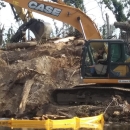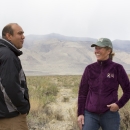Partners for Fish and Wildlife Program in Florida
The Partners for Fish and Wildlife (PFW) Program delivers on-the-ground habitat restoration projects that benefit at-risk and federal trust species including threatened and endangered species, migratory birds, and anadromous fish. Projects restore and enhance degraded habitat and, in some cases, create new habitat.
Partners Wanted
This program operates on a voluntary basis, so please contact us with ideas and questions! In addition to partnerships with private landowners, we work with private organizations, schools, and local, state, or other non-federal government programs.
Restoring Habitats on Private Lands
Partners for Fish & Wildlife is a pro-active program that promotes voluntary participation by landowners by providing financial and technical assistance for planning and implementing habitat improvements on their property.
Highest priority projects are those that restore native habitat and provide long-term benefits to at-risk and Federal trust species. Of particular interest are species that have been petitioned for listing, but whose status is still being evaluated (i.e., we are trying to avoid the need to list them). Examples of common project types include:
- Establishment of longleaf pine and other native trees and shrubs
- Native groundcover restoration
- Removing non-native vegetation
- Restoring ephemeral and other wetlands for native wildlife
- Livestock exclusion fencing and off-site watering
- Improving in-stream habitat conditions for mussels, crayfish, and other aquatic fauna
- Addressing water quality and quantity in springs and aquatic caves
How the Program Works
First, an interested landowner, or a representative, contact us (see contacts listed below) to ask questions and discuss ideas.
Arrange for a site visit
Projects are developed year round. A USFWS Partners biologist will meet on site with the landowner and anyone that they would like to be present to discuss the landowner's goals and objectives for restoring habitat on the property.
Often, county foresters, NRCS conservationists, or state fish and wildlife biologists take part in the discussions to address the landowner’s goals. The Partners biologist helps determine effective habitat improvements for the project property, including advice on design, techniques, work plan and budget.
Project selection
The Fish and Wildlife Service will provide technical advice on project design, materials to be used, and for aquatic restorations, the plan for engineering as needed. Funding and cost share responsibilities will be discussed.
Although we conduct site visits and develop plans for restoration projects any time of year, agreements are typically finalized in summer with project funding available in fall or winter.
Develop a project work plan
A Habitat Restoration Design is developed by the participating partners together with the Fish and Wildlife Service project managers. The USFWS biologist is responsible for completing an appropriate environmental review, including the required National Environmental Policy Act review, an endangered species consultation, a contaminant site assessment and a cultural resource review.
If funding is approved, a Landowner Agreement is developed and signed by the participating partners, and a method of payment is determined in order to reimburse the landowner or contractor. The landowner agreement secures the federal investment and is like a formal handshake that outlines each partner's responsibilities and outlines the project goals and costs.
Project implementation
A Notice of Award is then issued to the landowner obligating the necessary funding for implementation of the project.
The last step is implementation and enjoying the results!
Florida Goals and Project Prioritization
Florida encompasses incredible ecological diversity. It has ten distinct ecoregions with habitats ranging from coastal estuary to desert scrub. These habitats support over 130 endangered and threatened species, several unique plant communities, and a variety of economic and land-use considerations. We have lots of opportunity with nearly 18 million acres of private lands in Florida. Our partners are varied: family-owned farms or ranches; industrial and non-industrial forests; small landowners; dairy operations; and many others. The PFW program in Florida recognizes the unique issues involved in working to restore habitats in these varied climates and recognizes the unique landowner needs that are a reality for making our projects work.
Emphasis on Developing Quality Projects
Projects that restore habitat for or reduce threats to at-risk species will be given priority. In addition to currently listed species, Florida has more than 130 species that have been petitioned for listing. By improving habitat and reducing threats, the Partners for Fish and Wildlife Program aims to avoid or remove the need to list species for federal protection. To achieve this goal the Partners program in Florida has been focused on the restoration of longleaf and upland pine systems, scrub, dry prairie, wetlands, stream and riparian riparian
Definition of riparian habitat or riparian areas.
Learn more about riparian habitats. Nearly all of the listed, proposed, and candidate animal species in Florida rely on one or more of these habitats.
General Project Criteria
Proposed projects will be ranked based on potential benefits to listed or at-risk species habitat, as well as proximity and/or connectivity to conservation lands or areas of known populations of listed or at-risk species. Funded projects will meet one or more of the following criteria:
- Benefit to listed or at-risk species;
- Implements priority tasks in an established management, recovery, or restoration plan; and/or
- Provides long term protection of property.
- Other Factors Considered in Funding Projects
- Additional desired criteria include:
- Benefits to other FWS trust species, species of concern, or migratory birds;
- Proximity to National Wildlife Refuge property and compliments formal objectives of Refuge;
- Builds new partnerships in key resource area;
- Leverages resources (i.e. good dollar for dollar match);
- Good price per acre for project;
- Documented need for restoration;
- Results in a self-sustaining system not dependent on artificial structures;
- Provides educational or public outreach potential;
- Collaboration with state fish and wildlife and other partners;
- Reduces habitat fragmentation;
- Restores globally or nationally imperiled habitat type;
- Benefits multiple priority species;
- Current and future adjacent land use is compatible with restoration; and
- Long term oversight / management capability.
Other Factors Considered in Funding Projects
For a more comprehensive list of at-risk species by county or HUC 8 watershed you can visit the NatureServe on-line map viewer.






